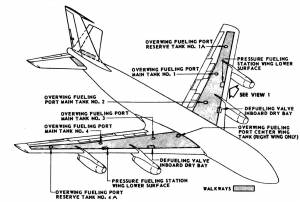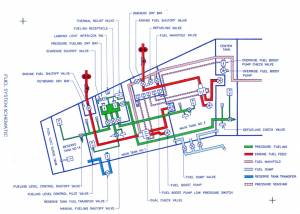All fuel is carried in the interspar area of the wing structure in four main tanks, two reserve tanks and a center tank. From each of the main tanks fuel is supplied under pressure directly to the corresponding engine by the main tank fuel boost pumps through fuel manifold valves and engine fuel shutoff valves. A fuel manifold enables the center tank or any of the main tanks to deliver fuel to any or all  engines.
engines.
Fuel may be supplied to the engine from the fuel manifold by opening the fuel manifold valve and shutting off or overriding the main tank fuel boost pumps to that engine by operation of the center tank override fuel boost pumps.
Fuel from the reserve tanks can be used only after it has been transferred by gravity through reserve tank fuel transfer valves to adjacent outboard main tanks. Each fuel tank, except the two reserve tanks, is
equipped with two electrically powered boost pumps. Fuel can flow from a main tank to its respective engine by gravity, but center tank fuel can be supplied to the engine only if an override fuel boost pump is operating. Intertank transfer of fuel between main and center tanks is prevented by check valves.
Dripsticks are installed to measure the actual fuel level in each tank to have an independent fuel quantity information without using the electrical operated fuel quantity indication system used during flight. Fuel system controls are on the FIE’s lower panel, lower auxiliary panel, upper panel and upper auxiliary panel. Fuel system indicators are on the pilot’s center panel and the FIE’s lower panel. For standard
fueling an underw ing pressure fueling system is used, incorporating manual fueling shutoff valves, and pressure actuated fueling level control shutoff valves. Provisions are also made for overwing fueling through standard filler receptacles. For de fueling on ground, manually operated defueling valves are installed. Partial defueling can also be accomplished through the pressure fueling system (pressure
ing pressure fueling system is used, incorporating manual fueling shutoff valves, and pressure actuated fueling level control shutoff valves. Provisions are also made for overwing fueling through standard filler receptacles. For de fueling on ground, manually operated defueling valves are installed. Partial defueling can also be accomplished through the pressure fueling system (pressure
fueling station).
